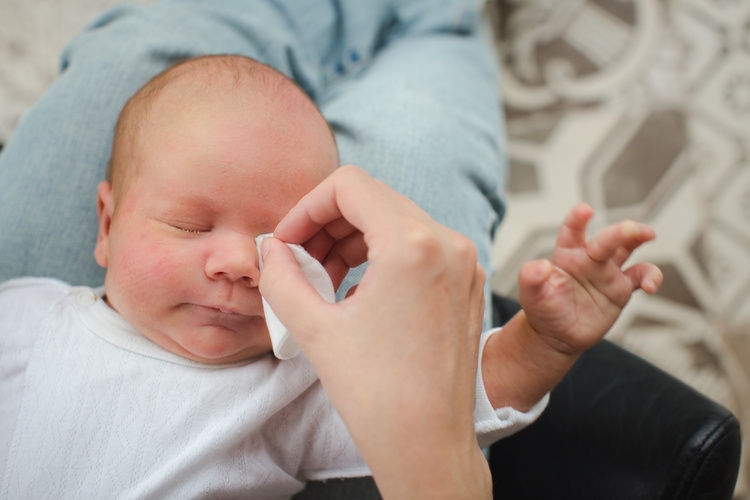Conjunctivitis is an inflammation of the conjunctiva, which is the clear membrane that covers the eye. Conjunctivitis is quite common. In some cases, it is quite contagious, and it is also, fortunately, quite manageable in adults, children, and babies alike.
What causes conjunctivitis?
Conjunctivitis can be a bacterial infection, viral infection, or allergic reaction. If your little one is showing symptoms of conjunctivitis for more than two days or you are otherwise concerned (eg the eyes are really sore and there is a lot of pus), it’s time to take them to the doctor for a diagnosis of which type of conjunctivitis they have.
Bacterial and viral conjunctivitis are very contagious – they can be transmitted easily via hands and fingers, face towels, or anything that has come into contact with discharge from an infected eye.
Allergic conjunctivitis is not contagious. It is caused by allergens and may be accompanied by sneezing, watery eyes, an irritated nose, or you may notice your child rubbing their eyes a lot.
How do I know if my child has conjunctivitis?
Symptoms of conjunctivitis can be slightly different between bacterial, viral, and allergic conjunctivitis. Generally, bacterial conjunctivitis will affect both eyes, whereas viral conjunctivitis might affect only one eye. Symptoms of conjunctivitis overall to look out for include:
- Red or pink eye/s
- Red eyelid/s
- Puffy or swollen eye/s
- Watery eye/s
- Yellow or green discharge
- Eye/s crusted shut in the morning or after a nap
- Sensitivity to light
- Rubbing of the eyes
- Complaints of a gritty or sandy feeling in the eyes
- Pus from the eye
If your child’s eye seems irritated for more than two days or is producing pus, consult your doctor for a diagnosis and to make sure there isn’t something stuck in the eye.
How can I manage my child’s conjunctivitis?
Each type of conjunctivitis is treated differently. Chat to your pharmacist or doctor for advice about managing the kind of conjunctivitis your child has. They may give you some of the following tips (this list is not a substitute for medical advice).
- Bacterial conjunctivitis is generally treated with antibiotic eye ointment or drops.
- Allergic conjunctivitis can be treated by antihistamine eyedrops, as prescribed by your doctor. Avoiding allergy triggers such as pollen and animal dander can also help to ease symptoms.
- Viral conjunctivitis typically doesn’t need a prescribed treatment, but it’s important to have a doctor’s diagnosis. You can clean your child’s eye when they have viral conjunctivitis with a soft, damp, clean gauze cotton pad. Do not use regular cotton balls as the small fibers can irritate the eye. Wipe from the inside corner of the eye (closest to the nose) outward. Only use each cotton pad for one wipe, and discard it immediately.
If your little one’s eyes still seem sore, inflamed, crusty, swollen, or infected after three to four days of treatment, make a follow-up appointment with your doctor.
Can I prevent conjunctivitis?
Conjunctivitis is highly contagious and easy to transmit, but there are some steps you can take to minimize the chances that your child may catch it. Avoid sharing towels or face washers and throw away tissues that have touched the eye
As you know, your child will likely touch whatever they want! If your baby or toddler does get conjunctivitis, don’t panic. It usually clears up within a few days with the right treatment, and almost never has a lasting effect.



